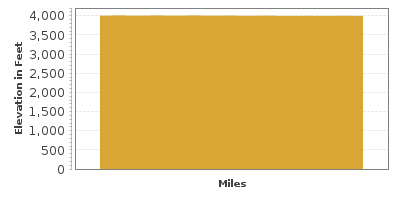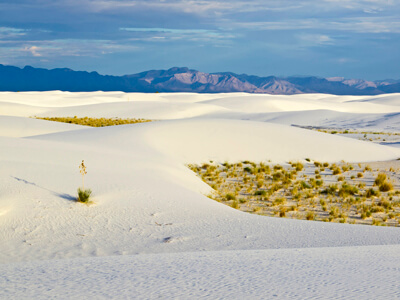White Sands National Park
Explore the gypsum dunes
| Mileage | 8 miles (14 km) |
|---|---|
| DurationThe duration is an estimate of a one-way drive and does not include any stops or side-trips. | 21 minutes |
| SeasonsThe seasons listed are the best seasons for this scenic drive. If Winter is not mentioned, the road may be closed during the winter. | Fall, and Winter |
| Roadways | Dunes Drive |
| Gravel Roads | Yes |
| ServicesThe cities or towns listed have either Food or Services such as gas, pharmacies, etc. | Alamogordo, NM▼, and Las Cruces, NM▼ |
| Rating | 3.2 average from 40 votes |
| My DrivesTrack your favorite scenic drives by selecting those which you want to take and those that you have taken. Using your free account, simply sign in and select My Drives. | |
| Share |
Our free Road Trip Planner will reverse the route and include the places of interests. Click the “Add to Road Trip” above to start planning your next road trip.
Send this link to your phone. Standard text messaging rates apply.
() -Get directions from your start address to the beginning of and including this scenic drive. Choose either an alternate ending or same as start.
Have more destinations? Use our free Road Trip Planner to completely plan your adventure. Click the “Add to Road Trip” above to start planning your next road trip.

Through glistening gypsum crystal dunes, this scenic drive travels White Sands National Park’s Dunes Drive, which is off of US-70. From I-25, take Exit 6 and head north on US-70 for about 40 miles where Dunes Drive will be on your left. From Alamogordo, head south on US-70 for 22-miles, where Dunes Drive will be on your right. It will take approximately 40 minutes for the full round trip drive, but leave time for walking, hikes, and photographing the stunning and surreal scenery at the many pullouts. Once known as White Sands National Monument, this site was designated White Sands National Park on December 20, 2019.

The park is surrounded by the White Sands Missile Range. The roads are occasionally closed to traffic as test missiles are fired. It is best to contact the park the day before arriving to check on closures, either on nps.gov or by calling (575) 679-2599.
Once you enter, stop at the White Sands National Park Visitor Center (I1) on your right. This is a great place to learn about the unusual and magical landscape. Take in one of their interpretive programs such as Sunset Strolls, or Full Moon Bike ride. The center also features a museum, bookstore and gift shop.
The wave-like dunes create a blanket of shifting shadows. Patterns streak, ripples fold, portraying hundreds of shades of white. The contrast of brilliant blue skies is a photographers dream. The white sands are actually gypsum crystals created by the evaporation of Lake Lucero and Alkali Flat, a remnant of the ancient Lake Otero. Blowing winds create magnificent dunes which move west to east as much as thirty feet per year. Looking a lot like snow, a popular activity is sledding on the dunes. It is permitted where there is no vegetation and away from parking area and roads. Sleds can be purchased at the visitor center.
A variety of animals have adapted to the harsh conditions. Most are nocturnal and rarely seen, but you may glimpse darkling beetles, the bleached earless lizards, prairie rattlesnakes, or the roadrunner. Some of the dessert creatures have even developed white skin. Plants endure being buried by moving dunes and despite the harsh temperatures and lack of water, delight the senses with wildflowers. Sand verbena, scorpion weed, claret cup hedgehog cactus, yucca and cottonwood and a variety of sunflowers can be found here.
Get close with a hike. The Dune Life Nature Trail (H1) is a 1-mile round trip interpretative hike on the sand. The trail is marked by orange posts but you should always be aware of your surroundings as wind can erase footprints and landmarks. Carry a compass and have water on hand as there is none once you leave the visitors center.
Interdune Boardwalk is a short, 650 yard round trip, leading to a panoramic view at the top of a dune and is accessible for strollers and wheelchairs. Playa Trail, 500 yards round trip, leads to a playa, which is a low-lying area that fills temporarily with rain water.
For those seeking a longer hike, try the Alkali Flat Trail. This backcountry 4.6 mile round trip trail leads through an expansive landscape to the edge of Alkali Flat. If you don’t see orange trail markers, National Parks recommends that you turn back as it is easy to get disoriented and lost. Stay safe — sign-in and out at trailhead, do not hike alone, wear sunscreen and carry at least 1 gallon of water per person.
From here, head north on US-70 to Alamogordo where you can continue onto the Billy the Kid Trail.
Other Nearby Places of Interests
Alkali Flat Trail (H2): Alkali Flat Trail. This backcountry 4.6 mile round trip trail leads through an expansive landscape to Alkali Flat, the lake bed of Lake Otero that creates these magnificent dunes. You do not need to walk the entire trail to enjoy the beauty of the dunes.




